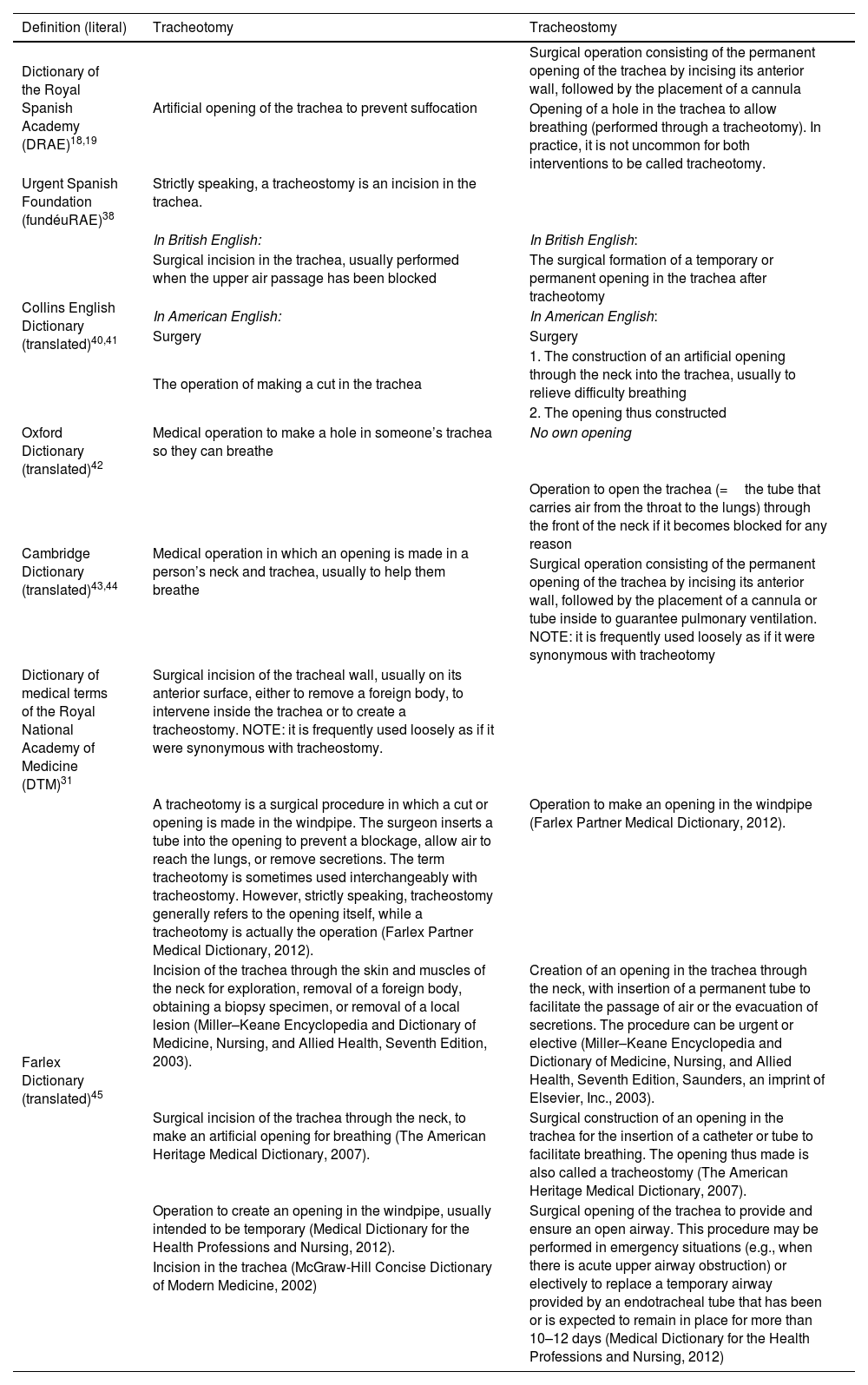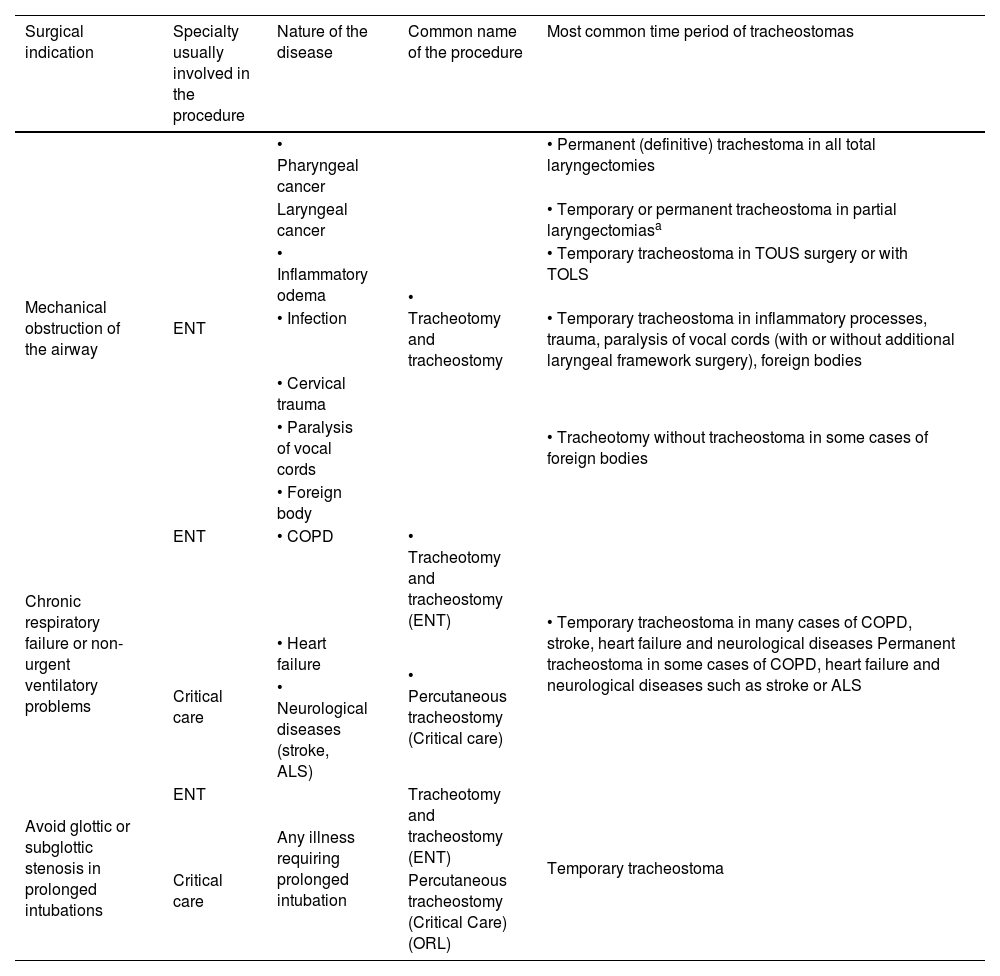In the healthcare field, the terms “traqueotomía” and “traqueostomía” are frequently used, often leading to confusion among professionals regarding the appropriate definition for each term or which one should be considered more correct in specific cases. A search was conducted for the terms “traqueotomía” and “traqueostomía” in general Spanish-language dictionaries such as the Dictionary of the Royal Spanish Academy (DRAE) and the Historical Dictionary of the Spanish Language of the Royal Spanish Academy (DHLE), as well as for the English terms “tracheotomy” and “tracheostomy” in English general dictionaries like the Oxford Dictionary, the Cambridge Dictionary, and the Collins English Dictionary. Additionally, searches were performed in medical dictionaries in both Spanish, specifically the Dictionary of Medical Terms of the National Academy of Medicine (DTM), and English, including the Farlex Dictionary. The terms were also explored using the Google search engine. Definitions were analyzed from both lexicographical and etymological perspectives. Definitions found in general dictionaries, in both Spanish and English, were found to be imprecise, limited, and ambiguous, as they mixed outdated indications with criteria that deviated from etymology. In contrast, definitions in medical dictionaries in both languages were more aligned with etymology. “Traqueotomía” strictly identifies the surgical procedure of creating an opening in the anterior face of the trachea. “Traqueostomía” identifies the creation of an opening that connects the trachea to the exterior, involving a modification of the upper airway by providing an additional entry for the respiratory pathway. “Traqueostomía” becomes the sole means of entry to the airway in total laryngectomies. Both terms can be used synonymously when a traqueotomía culminates in a traqueostomía. However, it is not appropriate to use the term “traqueostomía” when the procedure concludes with the closure of the planes and does not result in the creation of a stoma. Traqueostomas can be qualified with adjectives indicating permanence (temporary/permanent), size (large/small), shape (round/elliptical), or depth, without being linked to any specific disease or surgical indication. Not all permanent traqueostomas are the result of total laryngectomies, and they do not necessarily have an irreversible character systematically.
Con frecuencia se usan en el ámbito sanitario los términos traqueotomía y traqueostomía, pudiendo generar dudas entre los propios profesionales sobre qué definición corresponde a cada término o cuál de ellos debe considerarse más correcto en casos concretos. Se ha realizado una búsqueda de los términos «traqueotomía» y «traqueostomía» en los diccionarios generalistas en idioma español del Diccionario de la Real Academia Española (DRAE) y del Diccionario Histórico de la Lengua Española de la Real Academia Española (DHLE), y de los términos en inglés «tracheotomy» y «tracheostomy» en los diccionarios generalistas en idioma inglés del Oxford Dictionary, del Cambridge Dictionary y del Collins English Dictionary. Asimismo, se ha hecho una búsqueda en los diccionarios de términos médicos en español del Diccionario de Términos Médicos de la Real Academia Nacional de Medicina (DTM) y en inglés del Farlex Dictionary. Los términos se buscaron también en el buscador generalista de Internet Google®. Se analizaron las definiciones desde el punto de vista lexicográfico y etimológico. Las definiciones que aparecen en los diccionarios generalistas, tanto en español como en inglés, son imprecisas, limitadas y adolecen de ambigüedad por mezclar indicaciones desactualizadas con criterios alejados de la etimología. Sin embargo, las definiciones en los diccionarios de términos médicos en ambos idiomas están más ajustadas a la etimología. La traqueotomía identifica estrictamente el procedimiento quirúrgico de realización de una apertura en la cara anterior de la tráquea. La traqueostomía identifica la realización de un orificio que comunica la tráquea con el exterior e implica una modificación del tracto aéreo superior al proporcionar una entrada adicional de la vía respiratoria. Solo en las laringectomías totales la traqueostomía es la única vía de entrada al tracto aéreo. Ambos términos pueden utilizarse sinónimamente cuando una traqueotomía culmina con una traqueostomía. No convendrá utilizar el término traqueostomía cuando se produce el cierre de los planos al final del procedimiento y este no resulta en la creación de un estoma. Los traqueostomas pueden ser cualificados con adjetivos de tiempo de permanencia (temporal/permanente), tamaño (grande/pequeño), forma (redondo/elíptico), o profundidad por sí mismos, sin vincularse a ningún tipo de enfermedad o de indicación quirúrgica. No todos los traqueostomas permanentes tienen lugar en laringectomías totales ni tienen sistemáticamente un carácter irreversible.







